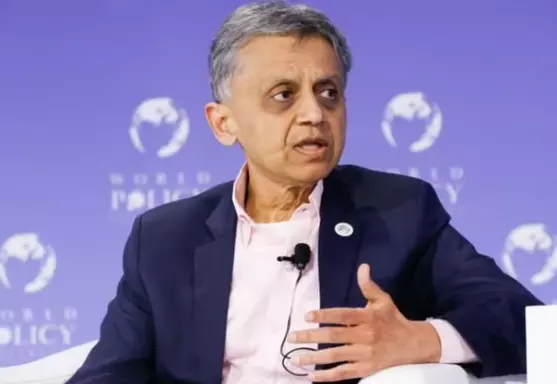
'India’s growth story ahead of G20 fake,' says Princeton University professor
Ashoka Mody says authorities have glossed over key macroeconomic facts while tabulating a billboard-worthy 7.8% growth rate ahead of the G20 meet and hide the struggles faced by a majority of Indians

Well-known academic Ashoka Mody has called out the Narendra Modi government, stating that its claims that India was a fastest-growing economy ahead of the G20 Summit was a “fake” one and was actually hiding the real struggles of Indian people.
Taking a dig at the G20 preparations in New Delhi and the large billboards flaunting “India’s growth story,” Mody, a visiting professor of economics at Princeton University, in an article in Project Syndicate, said despite India’s claim about a 7.8 per cent annual growth in the second quarter this year, the truth is that the growth is low, inequalities are rising and job scarcity remains acute.
Mody’s article was published in the web portal on Thursday (September 7).
‘Where are the discrepancies?’
Mody says the billboards which wax eloquent about India’s GDP growth conveniently miss the line about “discrepancies”.
“Normally an innocuous reporting convention in national accounts, the discrepancy is the difference between domestic income (earned by producing goods and services) and expenditure (what residents and foreigners pay when buying those goods and services). In principle, expenditure should equal income earned, because producers can earn incomes only when others buy their output. In practice, however, estimates of income and expenditure differ in national accounts everywhere, because they are based on imperfect data,” he says.
Stating that the discrepancy typically is not factored in while calculating growth rates (as income and expenditure have similar trends), “every now and then, the two series follow very different paths, with hugely consequential implications for evaluating economic performance.”
Mody says the Indian National Statistical Office’s latest report, pegging India’s GDP growth in April-June quarter at 7.8 per cent, and rise in expenditure by 1.4 per cent has several errors on this macroeconomic aspect.
“The NSO nonetheless treats income as the right one and assumes (as implied by its ‘discrepancy’ note) that expenditure must be identical to income earned. This is an obvious violation of international best practice. The entire point of the discrepancy line is to acknowledge statistical imperfections, not to make them disappear,” he says.
Mody says the NSO has tried to hide the reality of India’s “anaemic expenditure” when the truth is several “Indians are hurting” and “foreigners are showing only a limited appetite for Indian goods.”
“The proper approach is to recognize both income and expenditure as imperfect macroeconomic aggregates, and then to combine them to assess the state of the economy. Hence, the Australian, German, and UK governments adjust their reported GDP using information from both the income and expenditure sides,” he says.
‘India’s real growth rate is 4.5 per cent’
He cites the example of the US Bureau of Economic Analysis (BEA) which uses expenditure as its primary metric for economic performance and accounts for the often sizable difference between income and expenditure by reporting the average of the two as its composite measure.
Mody says if the same method is applied to India, its growth rate would fall from the touted 7.8 per cent to just 4.5 per cent, which he says is a “marked decline from 13.1 per cent in April-June 2022, when the post-COVID-19 rebound first triggered the current wave of India hype.”
Rising inequalities, rich-poor divide grows
Stating that the latest data is a red flag on the slowing growth, which again is a result of inequality and job crunch, Mody says the inequalities are reflected in the increased import content of domestic expenditure, which has gone up from its pre-COVID figure of 22 per cent to 26 per cent.
“With the help of an overvalued exchange rate, rich Indians are buying fast cars, gilded watches, and designer handbags – often on shopping sprees in Zurich, Milan and Singapore –while the vast majority struggle to buy necessities,” he says.
Speaking about the economy’s inability to create jobs, especially one ensuring a dignified standard of living, Mody says while finance and real estate, besides public administration, have registered the most rapid growth (12.1 per cent) in the past quarter, they too have managed to generate only a handful of jobs, and that too only for highly qualified Indians.
Why manufacturing sector needs a boost
Stressing that jobs in construction, which has got a boost from government’s infrastructure drive, and low-end services continue to be distressful careers for aspirants, Mody says the government has paid little attention to the manufacturing sector, which is the backbone of every successful developing economy.
“Following decades of disappointing growth, India’s post-COVID manufacturing performance has been particularly weak. This reflects the country’s chronic inability to compete in international markets for labor-intensive products – a problem made worse by the slowdown in world trade and weak domestic demand for manufactured products, owing to appalling income inequality,” he says.
Accusing Indian authorities of playing a cynical and “dangerous” game by putting up flattering images of growth ahead of the G20 Summit, Mody says they need to wake up and reconsider the path they have set India on.

